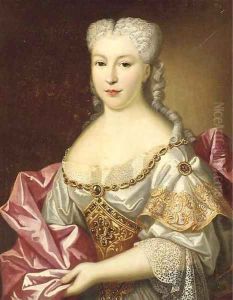Anthoine Pesne Paintings
Anthoine Pesne was a French Rococo painter known for his portraits and historical paintings. Born on May 29, 1683, in Paris, France, Pesne came from an artistic family; his father, Thomas Pesne, and his uncle, Charles de La Fosse, were both painters. His early training was under his father’s guidance, and he later continued his studies at the Académie Royale under the tutelage of the portraitist Hyacinthe Rigaud, who was one of the most sought-after portraitists of the time.
In the early 1700s, Pesne traveled to Italy to deepen his art education. While in Venice, he was influenced by the works of the Venetian masters, which is reflected in the vibrant palette and light treatment in his subsequent paintings. In 1710, he moved to Prussia at the invitation of King Frederick I, who was seeking to enhance the cultural standing of his court. Pesne quickly found favor with the Prussian royalty and was appointed the court painter, a position that allowed him to thrive professionally.
During his time in Prussia, Pesne became a pivotal figure in the development of the Rococo style in Northern Europe. He was instrumental in decorating the palaces of Sanssouci, Charlottenburg, and Schönhausen with both frescoes and canvas paintings. His portraits of the Prussian aristocracy and the royal family, including King Frederick II (Frederick the Great), were notable for their elegance, charm, and the use of light, which added a delicate and refined aura to his subjects.
Apart from portraits, Pesne also painted mythological and allegorical scenes, which were popular among the aristocracy of the time. He was praised for his ability to imbue these scenes with a sense of grace and playful imagination, characteristics of the Rococo movement.
Pesne's success in Prussia was confirmed when he was named the director of the Berlin Academy of Arts in 1723, a position he held until his death. His influence extended beyond painting, as he played a significant role in shaping the artistic tastes and preferences of the Prussian court and helped to establish Berlin as an artistic hub.
Anthoine Pesne died on August 5, 1757, in Berlin. His legacy endures through his substantial body of work, which captures the opulence and sophistication of the Rococo era. Today, his paintings can be found in various museums and collections, preserving the allure of the 18th-century European aristocracy and the artistic richness of the period.
